When we think about aquariums, it’s usually the flashy, colorful fish that grab all the attention. But let’s not forget about nerite snails—the quiet little workers who keep everything clean and running smoothly. These tiny guys might not be the stars of the tank, but they’re definitely the MVPs when it comes to maintenance. Sure, they only live for about 1 to 2 years and max out at around 0.5 to 1.5 inches in size, but they fit perfectly in just about any tank, no matter how big or small.
Nerite Snails (Neritidae) Species Profile

Aquarium enthusiasts are always on the hunt for the best ways to keep their tanks clean, and nerite snails are often the go-to solution. These little guys are not only great at controlling algae, but they also add a splash of beauty to any tank with their colorful, patterned shells. Originally from Africa and the Indo-Pacific, nerite snails are praised for being both eye-catching and super helpful when it comes to tank maintenance.
Where Nerite Snails Come From
Nerite snails have their roots in coastal regions of Kenya, Mozambique, and South Africa, where they thrive in both fresh and brackish waters. Their uniquely patterned shells make them a popular choice for aquarium lovers who want a tank that’s both balanced and beautiful.
Vitta Zebra’s Natural Habitat
The Vitta Zebra nerite snail, in particular, is found in flowing streams, rivers, and mangrove swamps. To keep these snails happy and healthy in your tank, it’s important to use mineral-rich water and substrates like crushed coral. This mimics their natural environment, ensuring they live longer and stay vibrant.
By recreating their natural habitat in your aquarium, you’re not only helping your nerite snails thrive but also keeping your tank clean and healthy. It’s a win-win!
Nerite Snail Types & Colors
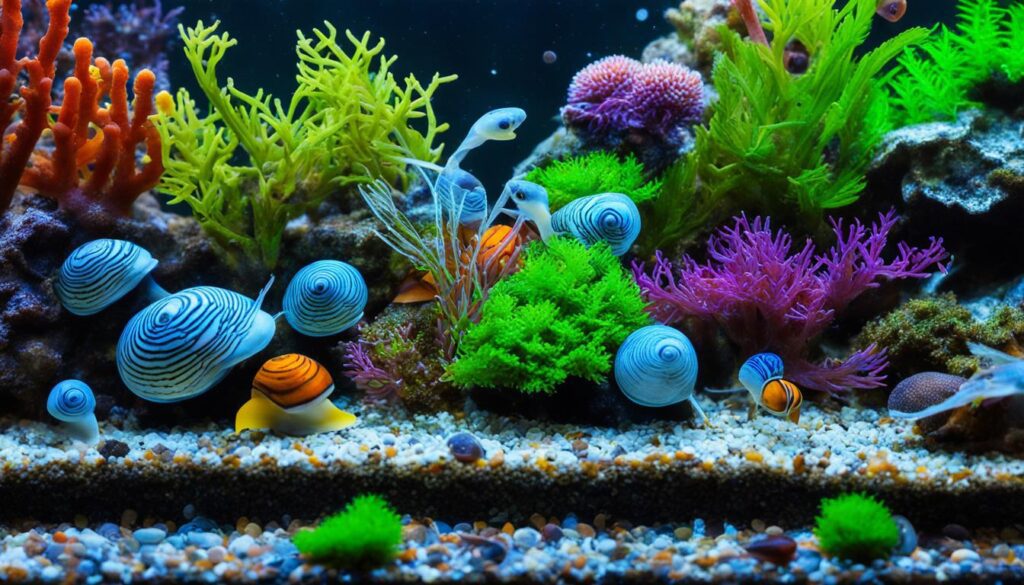
When diving into the world of nerite snails, you’ll quickly notice the amazing variety of colors and patterns they come in. These snails are known for their unique markings—some have striking stripes, while others sport spots. You’ve got species like the Zebra Nerite, Tiger Nerite, and Olive Nerite that really stand out with their eye-catching looks.
Nerite snails come in a range of colors, from deep blacks to vibrant golds, with shades of olive and even some red hues. Some even have cool horned textures! This variety lets me handpick the perfect species to not only brighten up my aquarium but also help keep it clean.
One of the main reasons people love nerite snails is their algae-eating superpowers. They do an awesome job of cleaning up algae, which keeps the water in your tank fresh and clear. So, not only are they fun to look at, but they also play a crucial role in maintaining a healthy environment.
Another bonus? They get along great with other peaceful fish, making them perfect tank mates. They do best in warm water, ideally between 72 to 78°F, and prefer a pH level around 7.5, which is pretty manageable for most aquariums.
All in all, if you’re setting up a new tank or looking to add something special to your current setup, nerite snails are a fantastic choice. They’ll boost the look of your aquarium while helping to keep it in top shape. With their ability to clean and peacefully coexist with other fish, they’re a must-have for any aquarium enthusiast.
1. Zebra Nerite
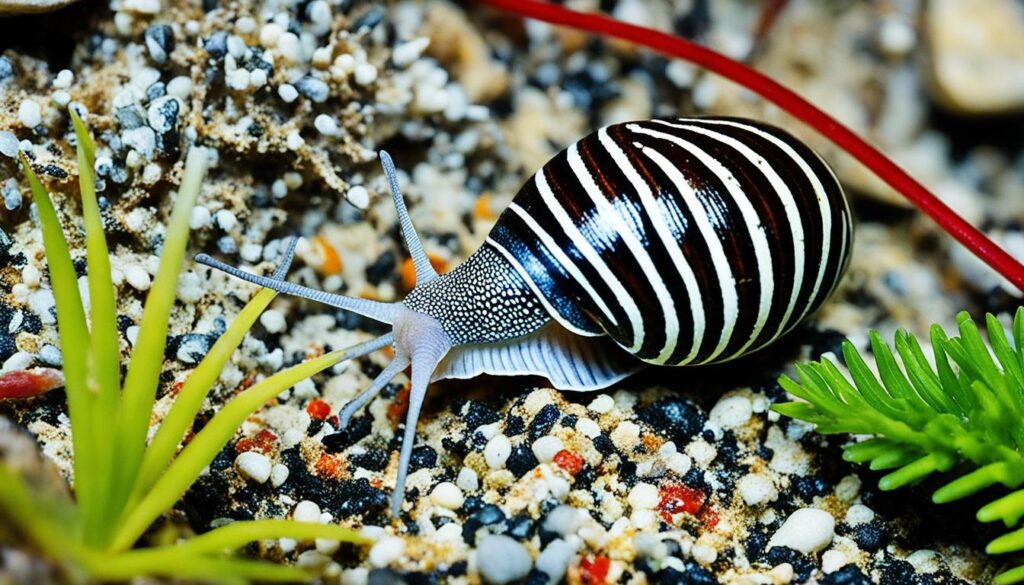
The Zebra Nerite Snail has a cool black and yellow striped shell. This makes it a favorite among aquarium fans. It’s great at controlling algae in tanks, keeping glass, plants, and decorations clean. This helps create a healthy space for all tank creatures.
For nerite snail care, it’s important to keep the water clean and at the right temperature. Zebra nerite snails do well in water between 65 and 85 degrees Fahrenheit. They also like a pH level of 6.5 to 8.5, fitting most freshwater tanks.
Parameter |
Recommended Range |
|---|---|
Size |
1/2 inch to 1 inch diameter |
pH Level |
6.5 – 8.5 |
Temperature |
65°F – 85°F |
Water Hardness (kH) |
12 – 18 |
Water Hardness (gH) |
12 – 18 |
Zebra nerite snails are peaceful and can live with other calm fish and creatures. Having at least five of them might help them breed. They breed best in brackish water, and their young grow into new shells as they get older.
Zebra nerite snail lovers suggest feeding them algae wafers or veggies like cucumber or zucchini. This helps them get enough food, especially in tanks with little algae.
To keep your zebra nerite snails happy, think about the whole tank’s health. Avoid sudden changes in water that could stress them out. Taking care of these things will help your snails thrive and keep your aquarium balanced.
2. Black Racer Nerite

The black racer nerite snail, known as Neritina pulligera, is a great addition to any aquarium. It comes from the Indo-Pacific regions. Its dark color and lively movement are not just pretty to look at. They also help keep the tank clean by eating algae.
For those looking for a nerite snail for sale, the black racer is a top pick. It’s tough and gets along well with other peaceful fish. But, remember, breeding them needs special conditions.
Feature |
Details |
|---|---|
Size |
Up to 1 inch |
Preferred Habitat |
Indo-Pacific regions, adaptable in aquariums |
Conservation Status |
Least Concern |
Ideal Tank Conditions |
5 gallons or larger, with 71.5-82.5 °F water temperature and pH of 7.0-8.0 |
Diet |
Algae, supplemented with shrimp food, algae tabs, and blanched vegetables |
Compatibility |
Peaceful; best kept with shrimp, avoid aggressive species |
Reproduction |
Requires brackish water for egg hatching |
Finding a nerite snail for sale is easy, but picking the right one, like the black racer, is key. They do well in many water conditions and are peaceful. This makes them great for both new and experienced fish keepers.
3. Red Racer Nerite
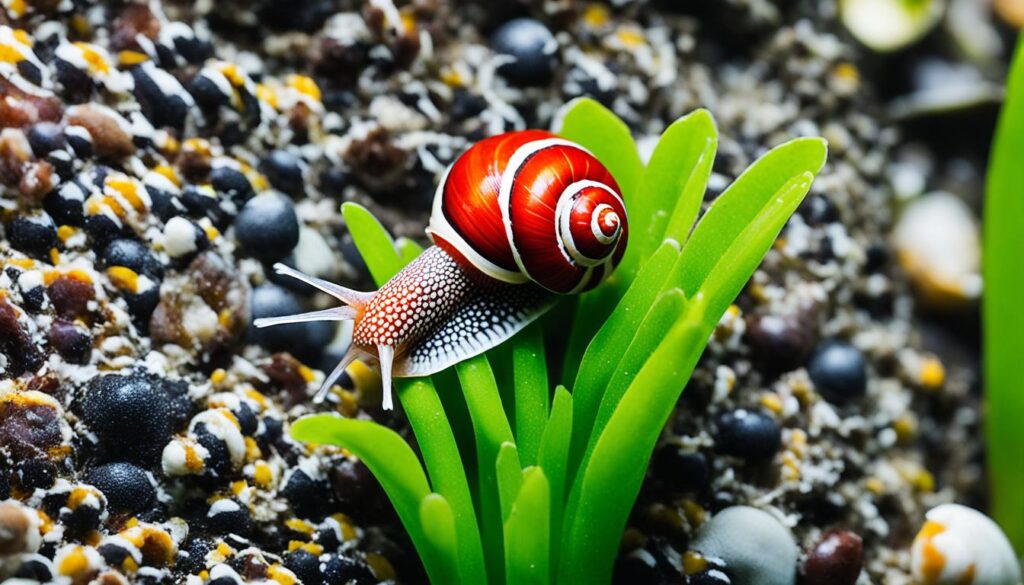
The Red Racer Nerite Snail stands out with its bright red and burgundy colors. It’s perfect for adding a pop of color to your aquarium. These snails are great for cleaning your tank by eating algae and keeping surfaces spotless.
These snails come in groups, making them a great deal for aquarium owners. You can buy them in packs of three for a good price. Plus, some sellers give you an extra snail for free, showing their quality and value.
- Size on Arrival: Often ranging between the size of a dime and a nickel.
- Adult Size: Can grow up to the size of a U.S. quarter.
- Life Span: Typically spans between 1 to 3 years.
For the Red Racer Nerite Snail to thrive, you need to keep the water just right. Make sure the pH, temperature, and hardness are balanced:
Parameter |
Range |
|---|---|
pH |
6.2 – 8.0 |
Temperature |
71.6° – 87.8°F |
KH |
4 – 6 |
GH |
8 – 12 |
TDS |
175 – 250 |
For best results, keep about 5 Red Racer Nerite Snails per gallon in your tank. This helps control algae without overloading the tank. When adding them, do it slowly to prevent stress.
These snails are calm and get along well with dwarf shrimp and other peaceful snails. But, be careful with some fish as they might harm the snails. If you want a snail that’s both beautiful and useful, the Red Racer Nerite Snail is a great choice.
4. Tiger Racer Nerite
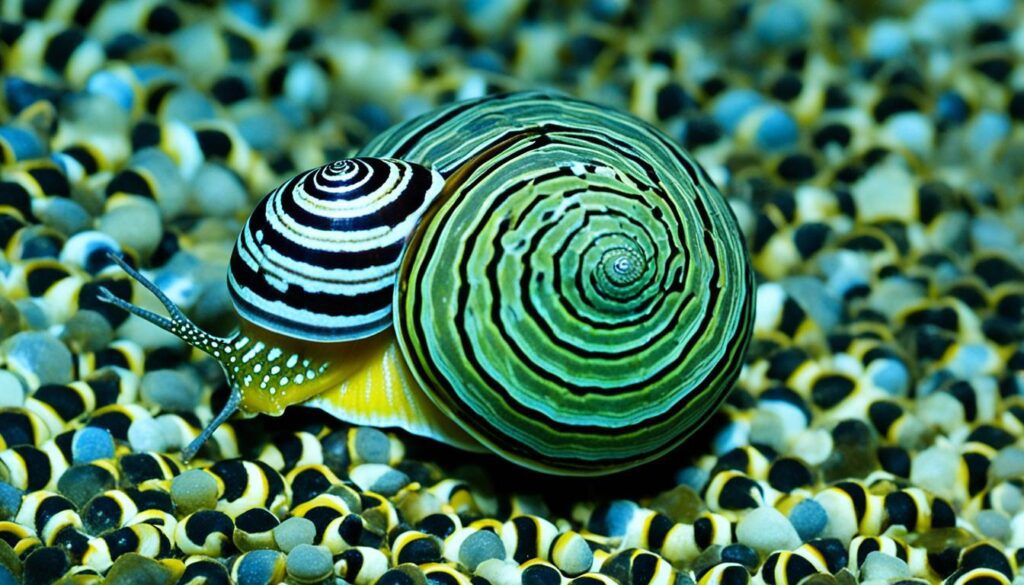
The Tiger Racer Nerite Snail (Neritina turrita) is a standout in any freshwater aquarium. It’s both beautiful and useful as a nerite snail algae eater. Its dark stripes look like a tiger’s, making your tank look better. At the same time, it keeps the tank clean by eating algae.
Tiger Racer Nerite snails are easy to care for and great for all aquarium owners. They are known for eating algae on tank surfaces. This makes them a top choice for keeping your tank clean.
These snails do well in freshwater tanks with a pH of 7.0 to 8.0, as stated by The Shrimp Farm. They also need water hardness of 6-12 dKH and a temperature of 72 – 78°F (22-26°C).
For those interested in the tiger racer nerite snail, it’s safe to keep with many other species. This includes fish, shrimp, and other snails. So, they fit well in almost any tank setup.
Feature |
Description |
|---|---|
Size |
Less than 1 inch in diameter |
Lifespan |
1-2 years |
Water pH |
7.0 – 8.0 |
Temperature |
72 – 78°F (22-26°C) |
Algae Consumption |
High – Effective at cleaning tank surfaces |
In conclusion, the tiger racer nerite snail is more than a pretty face. It’s a natural cleaner that keeps your aquarium healthy. With their easy care and friendliness to other tank mates, these snails are a great pick for any aquarium lover.
5. Olive Nerite
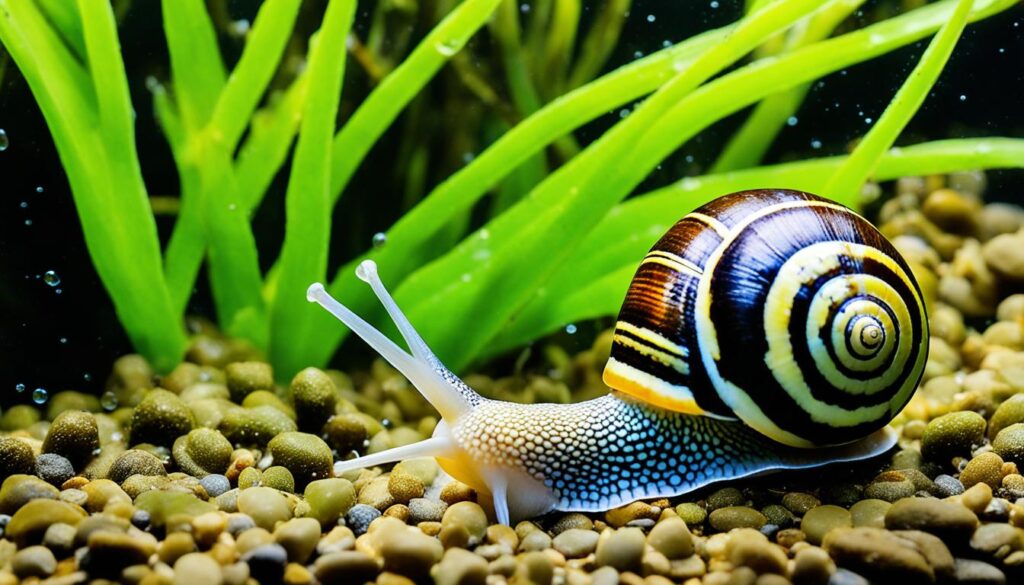
The nerite snail species includes the olive nerite snail, which is great for aquariums. It’s easy to care for, making it perfect for beginners. This snail is quick to adapt and helps keep the tank clean by eating algae and detritus.
They have a natural look that fits well in a realistic tank. This is great for those who like a calm look in their aquarium.
Learning about their needs is easy, but it’s fascinating to see how they clean algae despite their simple appearance. Here’s why the olive nerite snail is great for new aquarium owners:
- Exceptional algae-eating capability that keeps the tank clean
- Minimal risk of overpopulation, as they do not breed in freshwater
- Peaceful temperament, making them excellent tank mates for most fish
- Can thrive in a variety of water parameters, which is ideal for beginners like me
Deeper into their care, I’ve found they are easy to manage but need stable water with enough calcium for their shells. It’s like giving them a strong, safe home.
Feature |
Details |
|---|---|
Aquarium Size |
Recommended 5-6 snails for a 55-gallon tank |
Water Condition |
Can adapt to a range of conditions; calcium supplementation beneficial for shell health |
Compatibility |
Peaceful with most species; perfect for community tanks |
Diet |
Mainly algae; minimal feeding required |
Reproduction |
Does not breed in freshwater, preventing overpopulation concerns |
Choosing the olive nerite snail from the nerite snail species has made my aquarium journey easier. They are easy to care for and add a peaceful beauty to my tank.
6. Horned Nerite
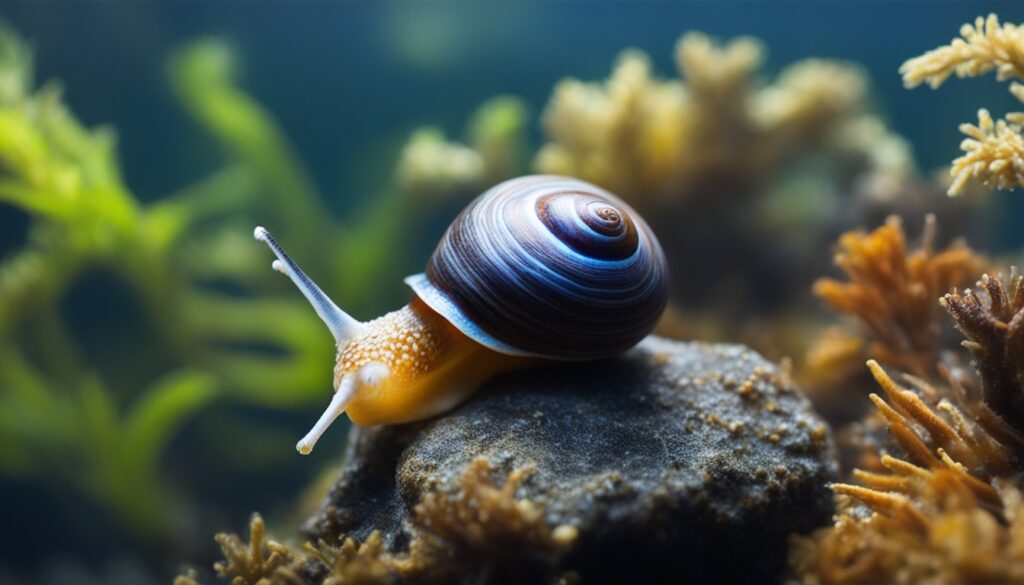
The horned nerite snail (Clithon Corona) is a standout in the Neritidae family. It’s known for its unique look and specific care needs. Its shell has horn-like protrusions, making it a fascinating sight in any aquarium.
These snails prefer a warm environment, between 72-82°F, with a pH of 7 to 8.2. They do well in tanks of 3 to 5 gallons, giving them enough room to move and interact with other tank mates.
Horned nerite snails get along well with peaceful fish and invertebrates. But, they need brackish water to breed, which can be tricky for some keepers. They thrive in water with a hardness of 12 to 25 and a carbonate hardness of 5-15.
When it comes to food, horned nerite snails are easy eaters. They enjoy algae, biofilm, diatoms, decaying plants, and can also have spirulina powder, algae wafers, or blanched veggies. Their ability to eat algae makes them great for controlling tank algae, making them a good choice for any aquarist.
Adding horned nerite snails to your tank requires careful acclimation, especially if moving from freshwater to brackish water. This process should be done slowly over 2 to 6 hours to reduce stress and keep the snails healthy.
The cost of these snails varies, with brackish ones being pricier than freshwater ones. Despite the cost, their unique look and tank benefits make them a great addition for aquarists aiming for a lively and healthy aquarium.
Ideal Tank Setup

Setting up the perfect nerite snail tank setup means knowing what conditions they need to thrive. It’s not just about making an aquarium. It’s about creating a home that keeps them healthy and long-lived. Here’s what you need to do:
Water Quality
For their natural brackish waters, keep the pH level between 7.5 and 8.5. Crushed coral in the substrate or filter can help with this. Also, change the water 10-20% every two weeks to avoid toxins and keep snails healthy.
Heating & Lighting
Keep the water warm, between 72°F and 78°F (22-26°C). This is perfect for their metabolism. Lighting isn’t crucial for snails, but it helps algae grow. Algae is key to their diet and health.
Tank Mates
Pick calm tank friends like Neon tetras, Dwarf cichlids, and small shrimps, like Cherry or Blue Jelly shrimp. Stay away from aggressive fish that might bother your nerite snails. A peaceful tank is best for their well-being and keeps the tank balanced.
Parameter |
Value |
|---|---|
Tank Size |
5 gallons per snail |
Temperature |
72° – 78°F (22° – 26°C) |
pH Level |
7.5 – 8.5 |
Water Hardness |
12 – 25 dH |
Nitrate Level |
<20 mg/L |
Required Companions |
Non-aggressive fish/shrimp |
Nutrition & Diet
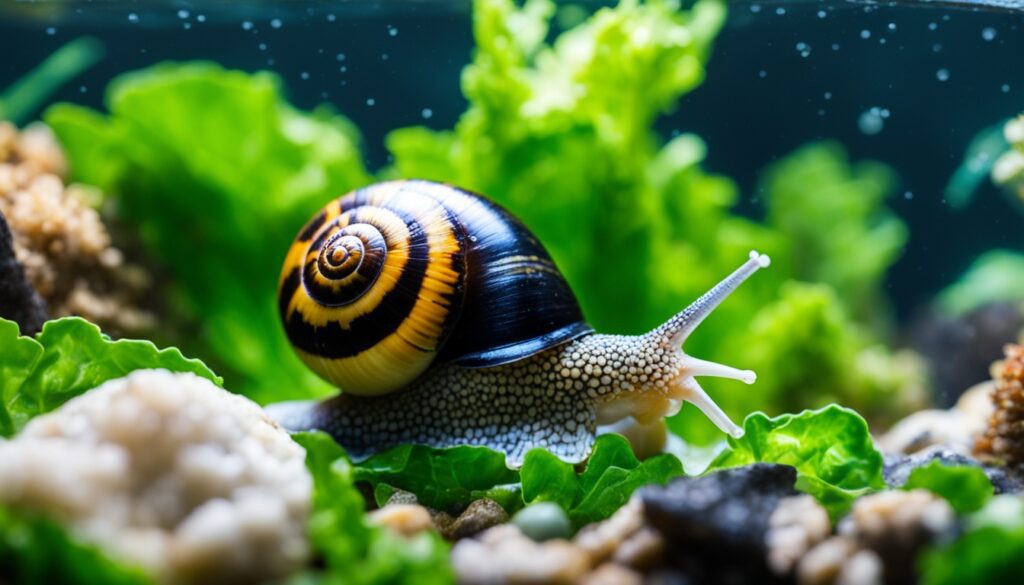
Getting the nerite snail’s diet right is super important for keeping them healthy and happy in your aquarium. These little guys are great at munching on algae and doing some serious tank cleaning. But if your tank doesn’t have a ton of algae, they’ll need a bit more to eat.
That’s where algae wafers come in handy. They provide the extra nutrients nerite snails need to stay healthy and keep their shells in good shape. You can also mix things up by offering blanched veggies like spinach, cucumber, and zucchini. This helps ensure they get a well-rounded and nutritious diet.
Here’s a list of good foods for nerite snails:
- Algae and biofilm
- Algae wafers or pellets
- Blanched leafy greens (spinach, lettuce)
But, there are foods you should not give to nerite snails. Foods with a lot of salt, sugar, or acid can hurt their health. Here’s what to avoid:
- Onions and garlic
- Avocado
- Citrus fruits (lemons, oranges)
Food Type |
Benefits |
Frequency |
|---|---|---|
Algae and biofilm |
Primary source of nutrition, helps maintain shell integrity |
Daily |
Algae wafers |
Supplies essential nutrients, promotes shell strength |
2-3 times per week |
Blanched vegetables |
Supplements diet, offers variety |
1-2 times per week |
To keep nerite snails healthy, make sure they get the right nutrients and live in a clean tank. Good nerite snail nutrition means feeding them well and keeping their home clean. This helps avoid health problems like cracked shells.
Breeding
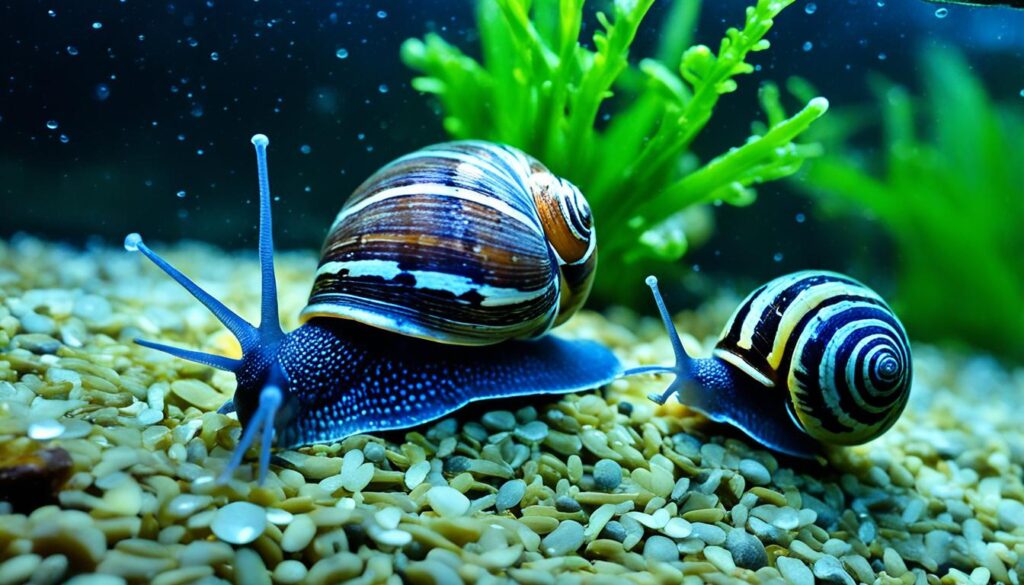
Nerite snail breeding comes with its own set of challenges, mainly because the larvae need brackish or saltwater to survive. Knowing how to breed nerite snails can really help you succeed. This is especially true when you have the right nerite snail tank setup.
Nerite Snails Sexing Guide
Sexing nerite snails is hard because they don’t show clear signs of being male or female. If you want to breed them, start with a group that has both males and females. Watching how the snails act and looking for eggs can help tell them apart.
After the snails lay eggs, usually on hard surfaces in the tank, you need to move them to a special environment. This new place must have the right salinity for the eggs to hatch. You’ll need to carefully change the water’s conditions to match what the eggs need.
Statistic |
Value |
|---|---|
Specific gravity for breeding |
1.005 – 1.015 |
Egg hatching time |
2 – 4 weeks |
Optimal temperature range |
20 to 30°C |
Optimal pH range |
7 – 8 |
Initial adult snail count for breeding |
3 |
Baby snails observed after hatch |
Approximately 20 |
Keeping the water stable is key for the health and breeding success of nerite snails. You need to keep the temperature, pH, and salinity right. It’s also important to feed the baby snails a lot of algae and infusoria. This helps them grow strong before moving them to freshwater.
Nerite snail breeding is complex and requires a lot of work. But, the joy of raising these snails can be very rewarding. It’s a great experience for aquarium lovers who take good care of their nerite snail tank setup.
What Makes Nerite Snails a Desirable Aquarium Resident?
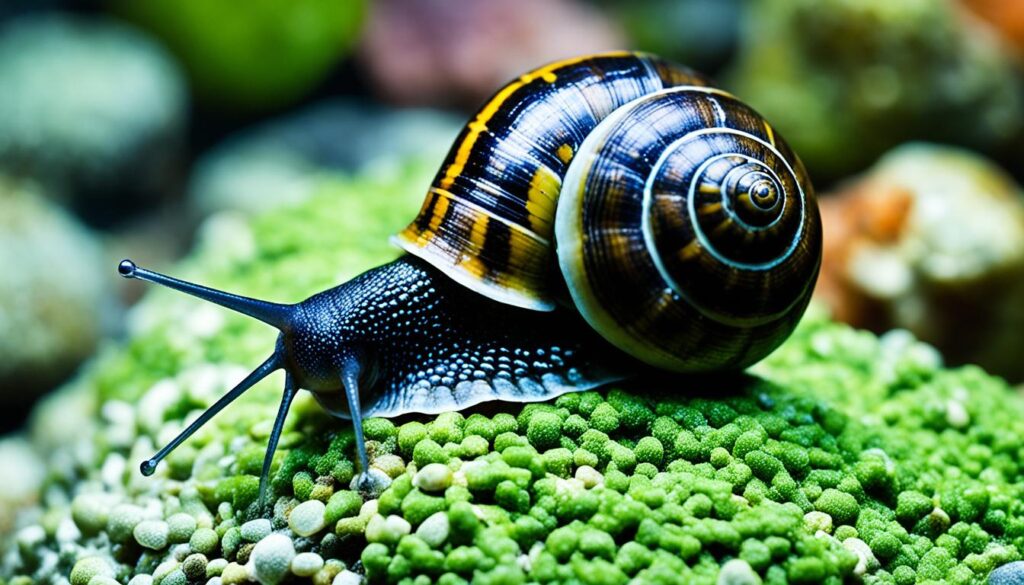
Nerite snails are a top pick for aquariums because of their easy care and their great job as nerite snail algae eaters. Many aquarists praise their simplicity and effectiveness. This makes them a favorite for both new and seasoned aquarium lovers.
Nerite snails are known for eating a lot of algae. They don’t eat plants or need special food like some snails do. They focus on cleaning the tank, making it easier to keep clean and looking better.
In my tank, nerite snails have changed the game. They’ve turned cleaning into a breeze, making everything in the tank work well together. Here’s why they’re better than other aquarium snails:
Snail Type |
Size |
Lifespan |
Special Characteristics |
|---|---|---|---|
Nerite Snails |
Up to 1 inch |
1-2 years |
Outstanding algae eaters, do not reproduce in freshwater |
Mystery Snails |
Over 1½ inch |
3-4 years |
Bright colors, good algae eaters |
Malaysian Trumpet Snails |
Up to 1 inch |
Variable |
Effective substrate cleaners but prone to overpopulation |
Up to 4 inches |
Up to 3 years |
Prefer warmer water, not primarily algae eaters |
|
About 1 inch |
2+ years |
Predatory, used to control snail populations |
The table shows how well nerite snails improve tank looks and help with upkeep with little effort. Nerite snail care is simple, just check the water and feed them if needed. This is why they’re loved as both pretty and useful pets.
In conclusion, nerite snails make aquariums easier to maintain and keep beautiful. They’re a perfect mix of beauty and usefulness, making them a favorite in the aquarium world.
Where to Buy Nerite Snails?
If you’re asking, “Where can I buy nerite snails?” and love adding these little cleaners to your aquarium, you’re in the right place. I personally like to visit local aquarium shops when I’m on the lookout for nerite snails, but I also check out online stores like Shrimpy Business. They offer a great selection of species, including Batik, Zebra, Tiger, and Red Racer Nerites. It’s always exciting to find just the right color and species that fits the vibe of my tank.
Shrimpy Business is especially known for its quality and customer service. Plus, the prices are pretty reasonable, ranging from $9.99 to $13.99. If you’re new to the aquarium scene, nerite snails are perfect for beginners. They’re low-maintenance and help keep things clean by munching on tank debris—just toss in some snail food every now and then to supplement their diet.
Before you buy, though, it’s important to understand the right care. For instance, Zebra Nerite snails thrive in temperatures between 72-82°F, and you’ll need to pay attention to water hardness to keep them healthy.
Also, it’s not just about buying them and tossing them in the tank. Make sure you’ve got the right tank size (at least 3-5 gallons) and water conditions. If you’re thinking about breeding nerite snails, you’ll need to set up brackish water, as they don’t breed in pure freshwater.
Knowing their needs is key to keeping your aquarium vibrant and ensuring your snails thrive.








